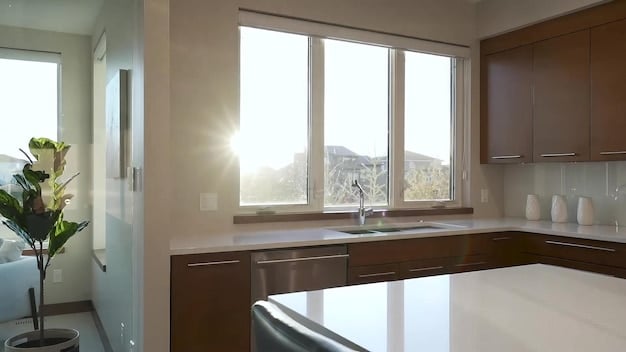Sustainable Home Renovations: Boost Value & Reduce Footprint

Sustainable home renovations increase property value and reduce your carbon footprint through energy efficiency, water conservation, and the use of eco-friendly materials, contributing to a healthier planet and more comfortable living.
Interested in enhancing your home’s value while contributing to a healthier planet? Sustainable home renovations offer a fantastic solution by reducing your carbon footprint and increasing your property’s appeal.
Understanding Sustainable Home Renovations
Sustainable home renovations involve making eco-conscious choices when upgrading your home. This goes beyond just aesthetics; it’s about using materials, techniques, and technologies that minimize environmental impact.
By focusing on sustainability, you not only reduce your carbon footprint, but also create a healthier living environment for yourself and your family, while also potentially increasing your property value.
Key Principles of Sustainable Renovations
Several key principles guide sustainable renovations, ensuring that every decision aligns with environmental responsibility.
- Energy Efficiency: Improving insulation, installing energy-efficient windows, and using smart thermostats.
- Water Conservation: Installing low-flow fixtures and rainwater harvesting systems.
- Material Selection: Choosing recycled, reclaimed, and locally sourced materials.
- Waste Reduction: Minimizing construction waste through careful planning and recycling.
Ultimately, sustainable home renovations are about integrating green strategies into the structure of your home, aligning with environmental stewardship.

Benefits of Sustainable Home Renovations
Undertaking sustainable home renovations offers a multitude of benefits, extending beyond just environmental protection. It influences your finances, health, and overall lifestyle.
The perks include enhanced home value, lower utility bills, improved air quality, and a greater sense of comfort and well-being.
Financial Advantages
One of the significant benefits is the potential for long-term financial savings.
- Reduced Utility Bills: Energy-efficient appliances and better insulation cut down on energy consumption, lowering monthly bills.
- Tax Incentives and Rebates: Many governments offer incentives for homeowners who invest in sustainable upgrades.
- Increased Property Value: Homes with green features often command higher prices in the real estate market.
Sustainable renovations create a cost-effective home that aligns with global ecological values, offering long-term financial relief.
Health and Lifestyle Improvements
Beyond finances, sustainable renovations positively impact health and lifestyle.
- Improved Indoor Air Quality: Using low-VOC paints and natural materials reduces harmful chemicals in your home.
- Enhanced Comfort: Better insulation and efficient HVAC systems create a more comfortable living environment year-round.
- Reduced Environmental Impact: Living in a sustainable home allows you to minimize your carbon footprint and contribute to environmental preservation.
Choosing sustainable home renovations transforms your living space into a haven of health, comfort, and environmental responsibility.
Planning Your Sustainable Renovation
Effective planning is crucial for a successful sustainable renovation project. This includes defining your goals, setting a budget, and finding the right professionals.
Taking a structured approach ensures that your project remains on track, within budget, and truly aligned with your sustainability objectives.
Setting Goals and Budget
Start by outlining what you hope to achieve.
Are you focused on reducing energy consumption, conserving water, or improving air quality? Establishing clear goals will guide your decisions throughout the renovation process.
Next, develop a realistic budget that accounts for materials, labor, and potential unexpected costs. Prioritize upgrades that provide the greatest return on investment, both financially and environmentally. Also consider ways to maximize your budget to get the best deal, balancing cost and quality, without compromising green values.
Finding the Right Professionals
Collaborating with experienced and knowledgeable professionals is vital for a successful renovation. Look for contractors, architects, and designers who specialize in sustainable building practices.
Verify their credentials, review their past projects, and ask for references. A skilled team can provide valuable insights, helping you navigate the intricacies of sustainable renovations and achieve your goals effectively.
Energy Efficiency Upgrades
Energy efficiency upgrades are a cornerstone of sustainable home renovations. These upgrades reduce energy consumption, lower utility bills, and minimize your home’s environmental impact.
A combination of insulation improvements, efficient windows and doors, and advanced climate control methods maximizes energy savings and home comfort.
Insulation Improvements
Proper insulation is essential.
Insulation plays a critical role in keeping your home comfortable year-round. Upgrade your insulation in attics, walls, and basements with eco-friendly materials like recycled denim, cellulose, or sheep’s wool. Proper insulation minimizes heat loss in winter and heat gain in summer, reducing the need for excessive heating and cooling.
Prioritizing air sealing and insulation can significantly reduce energy waste and create a comfy environment, while also enhancing sustainable living.
Efficient Windows and Doors
Replacing old windows and doors with energy-efficient models can have a significant impact.
Opt for windows with low-E coatings and argon gas fills, which reduce heat transfer and improve insulation. Look for doors with high insulation values and tight seals to prevent drafts. By investing in energy-efficient windows and doors, you can enhance your home’s comfort and improve energy efficiency dramatically.

Water Conservation Strategies
Conserving water is another essential aspect of sustainable home renovations. These strategies reduce water consumption, lower water bills, and help preserve this precious resource.
By implementing low-flow fixtures, rainwater harvesting systems, and other water-saving techniques, you can contribute to a more water-conscious lifestyle.
Low-Flow Fixtures
Installing low-flow fixtures such as showerheads, faucets, and toilets can significantly reduce water usage.
Low-flow showerheads use innovative designs to provide a satisfying shower experience while using less water. Similarly, low-flow faucets incorporate aerators to reduce water flow without compromising water pressure. Dual-flush toilets allow you to choose between a full flush and a partial flush, saving even more water.
Rainwater Harvesting Systems
Harvesting rainwater is an excellent strategy for conserving water and reducing your reliance on municipal water supplies.
Install a rainwater harvesting system to collect rainwater from your roof and store it in a tank. This water can then be used for irrigation, washing cars, and other non-potable purposes. Rainwater is naturally soft and free from chemicals, making it ideal for many uses around your home.
Choosing Sustainable Materials
The materials you choose play a critical role in sustainable home renovations. Selecting eco-friendly materials reduces environmental impact and promotes a healthier indoor environment.
Recycled, reclaimed, and locally sourced materials are excellent options for creating a sustainable home and supporting environmental protection.
Recycled and Reclaimed Materials
Using recycled and reclaimed materials helps reduce demand for virgin resources and diverts waste from landfills.
- Recycled Glass Countertops: Made from post-consumer glass, these countertops add a unique touch to your kitchen or bathroom.
- Reclaimed Wood Flooring: Salvaged from old buildings or structures, reclaimed wood flooring adds character and warmth to your home.
- Recycled Metal Roofing: Made from recycled aluminum or steel, these roofs are durable, energy-efficient, and environmentally friendly.
By incorporating recycled and reclaimed materials, you can reduce the environmental footprint of your renovation project.
Locally Sourced Materials
Sourcing materials locally reduces transportation emissions and supports local economies.
- Local Stone: Using locally sourced stone for landscaping or building projects reduces transportation costs and supports local quarries.
- Local Lumber: Using lumber from local forests ensures sustainable forestry practices and reduces the carbon footprint associated with long-distance transportation.
- Local Artisans: Hiring local artisans and craftsmen supports local economies and ensures that your home is built with high-quality, sustainable materials.
Choosing locally sourced materials promotes sustainability and fosters a sense of community.
| Key Point | Brief Description |
|---|---|
| 💡Energy Efficiency | Reduce energy use with better insulation, efficient windows, and smart thermostats. |
| 💧 Water Conservation | Use low-flow fixtures and rainwater harvesting to conserve water. |
| ♻ Sustainable Materials | Opt for recycled, reclaimed, and locally sourced materials. |
| 💰 Financial Savings | Lower utility bills, tax incentives, and increased home value. |
Frequently Asked Questions
▼
Key elements include energy efficiency, water conservation, using sustainable materials, and reducing waste. These practices minimize environmental impact and improve the home’s overall sustainability.
▼
Improve insulation, install energy-efficient windows, use smart thermostats, and switch to energy-efficient appliances. These upgrades will lower your energy bills and reduce your carbon footprint.
▼
Consider recycled glass countertops, reclaimed wood flooring, bamboo cabinets, and low-VOC paints. These materials are environmentally friendly and can add unique character to your home.
▼
Install low-flow showerheads, faucets, and toilets. Also, consider implementing a rainwater harvesting system for irrigation and other non-potable uses, conserving water effectively.
▼
While initial costs may be higher, sustainable renovations often pay for themselves over time through lower utility bills and increased property value. Plus, many incentives and rebates are available.
Conclusion
Sustainable home renovations are a wise investment for homeowners looking to increase their property value, reduce their environmental impact, and create a healthier living environment. By focusing on energy efficiency, water conservation, and sustainable materials, you can transform your home into a green, comfortable, and valuable asset that benefits both you and the planet.





